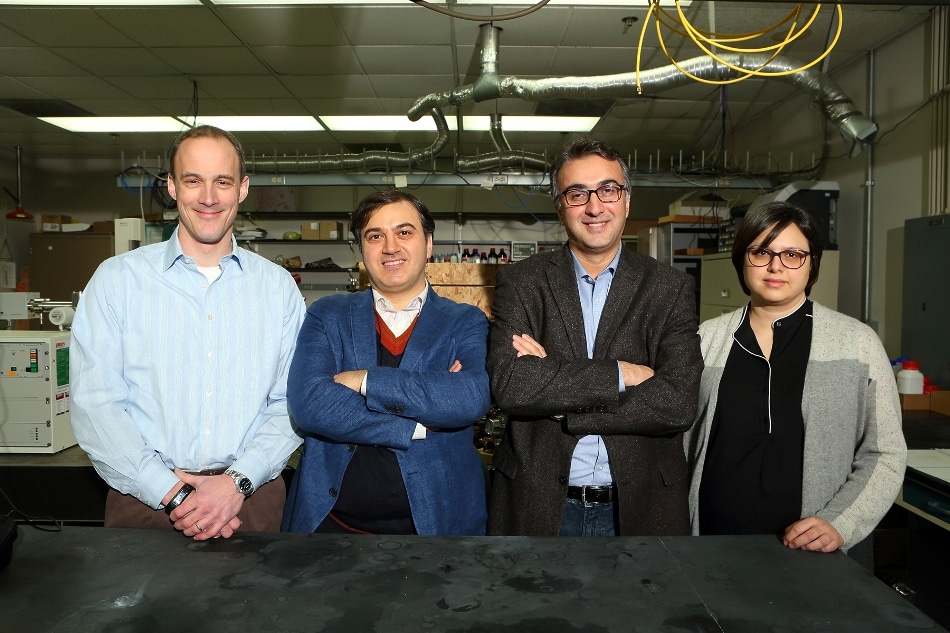Mar 22 2018
 Robert Klie, Mohammad Asadi, Amin Salehi-Khojin, and Fatemeh Khalili. (Credit: Jenny Fontaine)
Robert Klie, Mohammad Asadi, Amin Salehi-Khojin, and Fatemeh Khalili. (Credit: Jenny Fontaine)
Scientists from the University of Illinois at Chicago and Argonne National Laboratory have developed an innovative lithium-air battery that can be operated in an ambient environment for a record-breaking 750 charge/discharge cycles. The outcomes of their study have been described in the Nature journal.
Our lithium-air battery design represents a revolution in the battery community. This first demonstration of a true lithium-air battery is an important step toward what we call ‘beyond lithium-ion’ batteries, but we have more work to do in order to commercialize it.
Amin Salehi-Khojin, Assistant Professor, Mechanical and Industrial Engineering, University of Illinois at Chicago
Although lithium-air batteries are considered to have the capacity to hold nearly five times more energy when compared to lithium-ion batteries usually used in laptops, phones, and electric vehicles, battery researchers have always been tantalized by them. However, there have been a number of hurdles in achieving their development.
The batteries operate by mixing oxygen from the ambient air with lithium contained in the anode to synthesize lithium peroxide on the cathode during the discharging phase. During the charging phase, the lithium peroxide is again broken into its constituent elements— oxygen and lithium.
Regretfully, it has been difficult to operate experimental designs of such lithium-air batteries in a realistic ambient environment as a result of oxidation of the lithium anode and synthesis of unfavorable byproducts on the cathode that are formed when lithium ions combine with water vapor and carbon dioxide in the air. These byproducts get accumulated on the cathode, ultimately making the cathode entire coated and unable to operate. The working of these experimental batteries has been dependent on tanks of pure oxygen, restricting their practical usage and posing serious safety hazards as oxygen is highly flammable.
A few others have tried to build lithium-air battery cells, but they failed because of poor cycle life.
Larry Curtiss, Distinguished Fellow, Argonne
The UIC-Argonne research group solved these difficulties by using a distinctive combination of cathode, anode, and electrolyte (the three main components in a battery) to avoid anode oxidation and accumulation of battery-destroying byproducts on the cathode and to enable the battery to function under ambient environment.
A thin layer of lithium carbonate was coated on the lithium anode, which selectively allowed lithium ions in the anode to move to the electrolyte while blocking undesirable compounds from moving to the anode.
In the case of a lithium-air battery, the cathode is simply the part through which air enters into the battery. In the experimental lithium-air battery designs, oxygen, along with all the gaseous components of air, moves into the electrolyte through a carbon-based spongy lattice structure.
Salehi-Khojin and his team used a molybdenum disulfate catalyst as a coating on the lattice structure and used a distinctive hybrid electrolyte containing ionic liquid and dimethyl sulfoxide, a common constituent of battery electrolytes, which assisted in facilitating lithium-oxygen reactions, minimizing the reactions of lithium with other elements in the air, and enhancing the battery efficiency.
The complete architectural overhaul we performed on this battery by redesigning every part of it, helped us enable the reactions we wanted to occur and prevent or block those that would ultimately cause the battery to go dead.
Amin Salehi-Khojin, Assistant Professor, Mechanical and Industrial Engineering, University of Illinois at Chicago
The UIC team developed, investigated, analyzed, and characterized the battery cells. The Argonne group worked in collaboration with researchers at UIC and California State University to carry out the computational analyses.
Senior authors of the paper are Fatemeh Khalili-Araghi and Robert Klie from UIC and Mohammad Asadi of the Illinois Institute of Technology.
Co-authors of the paper are Baharak Sayahpour, Pedram Abbasi, Klas Karis, Jacob Jokisaari, Marc Gerard, Poya Yasaei, Xuan Hu, and Arijita Mukherjee from UIC; Anh Ngo, Cong Liu, Badri Narayanan, Rajeev Assary, and Larry Curtis from Argonne National Laboratory; and Kah Chun Lau from California State University.
The scientists used the Argonne Leadership Computing Facility and the Center for Nanoscale Materials, which are U.S. Department of Energy Office of Science User Facilities. Grant NSF-DMREF 1729420 from the National Science Foundation; a grant from the U.S. Department of Energy, Office of Science, Basic Energy Sciences; the Joint Center for Energy Storage Research, a DOE Energy Innovation Hub; and the Center for Electrical Energy Storage: Tailored Interfaces, a DOE Energy Frontier Research Center supported the study.